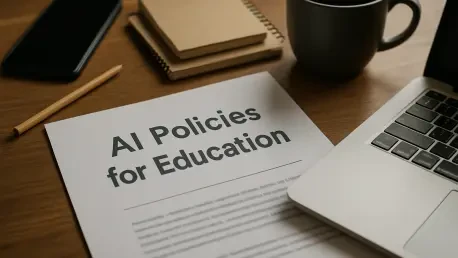In Allegheny County and Southwestern Pennsylvania, the rapid integration of Artificial Intelligence (AI) into educational environments has sparked a profound transformation, forcing school districts to rethink traditional approaches to learning and oversight, especially with tools like generative AI (gen AI), such as ChatGPT, becoming essential to both student assignments and teacher workflows. With the urgency to establish robust policies now evident, recent studies show that 40% of teenagers rely on gen AI for schoolwork, while a staggering 83% of educators incorporate it into their professional routines. This surge underscores a critical need for structured guidelines to harness AI’s potential while safeguarding academic integrity. Schools across the region are rising to the challenge, recognizing that preparing students for a world increasingly driven by AI is not just an option, but a necessity. This exploration delves into the multifaceted strategies districts are employing to balance innovation with responsibility, ensuring AI serves as a tool for enhancement rather than disruption.
The Push for Structured AI Governance
Policy Development Across Districts
The pervasive presence of AI in educational settings has prompted Allegheny schools to prioritize the creation of formal policies and guidelines, ensuring clarity on acceptable use. Districts vary in their progress, with some like Cornell School District having already adopted comprehensive frameworks, while others, such as Woodland Hills, remain in the drafting phase. The Pennsylvania School Boards Association plays a pivotal role by offering policy guides rooted in principles of responsible AI integration. These resources provide a blueprint for schools to navigate the complexities of technology in education, addressing both immediate classroom applications and broader ethical considerations. The emphasis is on creating rules that are adaptable, allowing for updates as AI technologies evolve and new challenges emerge. This proactive stance reflects a regional commitment to maintaining control over how AI influences learning environments, ensuring it aligns with educational goals rather than dictating them.
A key aspect of this policy development is the focus on transparency for all stakeholders—students, teachers, and parents alike. Many districts are working to communicate expectations clearly, often through public forums or updated handbooks, to eliminate confusion about AI’s role in academic settings. For instance, guidelines may specify when AI tools can be used for assignments versus when original work is required. This clarity is vital, as surveys indicate persistent uncertainty among families regarding permissible AI applications. Beyond just setting rules, some schools are integrating feedback mechanisms to refine these policies, ensuring they reflect real-world classroom dynamics. The overarching aim is to foster an environment where AI is a supportive tool, not a source of contention or unfair advantage. By tailoring policies to their unique needs, districts are laying the groundwork for a cohesive approach that prioritizes both innovation and accountability in equal measure.
Balancing Speed and Readiness
While the need for AI policies is universally acknowledged, the pace at which districts implement them varies significantly, reflecting a deliberate balance between urgency and thoroughness. Some schools, eager to address AI’s immediate impact, have fast-tracked policy creation to provide instant guidance for educators and students grappling with tools like gen AI. However, this rapid response sometimes risks overlooking nuanced challenges, such as ensuring equitable access to technology. Other districts adopt a more measured approach, taking time to assess their specific contexts and resources before rolling out guidelines. This careful strategy aims to avoid hasty decisions that might require frequent revisions, focusing instead on crafting frameworks that are both comprehensive and sustainable. The diversity in timing highlights a shared understanding that effective governance must prioritize long-term educational integrity over short-term fixes.
This balance also extends to how districts prepare for future AI advancements, ensuring policies remain relevant amid rapid technological shifts. Schools taking a slower path often engage in extensive consultations with educators, technology experts, and even students to gather diverse perspectives on AI’s role. Such collaboration helps identify potential pitfalls—like over-reliance on AI for grading—that might not be immediately apparent. Meanwhile, faster-moving districts often pilot smaller-scale guidelines before full implementation, using initial feedback to refine their approach. Regardless of speed, the common thread is a commitment to readiness, ensuring that when policies are enacted, they are robust enough to handle both current applications and emerging trends. This strategic variation across Allegheny County underscores a collective resolve to integrate AI responsibly, safeguarding the educational mission while embracing technological progress.
Training Educators for an AI-Driven Classroom
Equipping Teachers with Skills
As AI becomes a fixture in education, Allegheny districts are placing significant emphasis on professional development to ensure teachers are adept at using these tools effectively. Training programs often focus on practical applications, such as leveraging AI for lesson planning, creating personalized learning experiences, or streamlining grading processes with platforms designed for educators. Sessions may include hands-on demonstrations, like using AI to color-code assignments for better organization, which help demystify the technology. The goal is to build confidence among educators, enabling them to integrate AI seamlessly into their teaching without compromising pedagogical standards. By equipping teachers with these skills, schools aim to transform AI from a potential distraction into a valuable ally that enhances classroom efficiency and engagement, ultimately benefiting student outcomes.
Beyond technical know-how, these training initiatives also address the ethical dimensions of AI use, ensuring educators understand the boundaries of its application. Teachers learn to critically assess AI-generated content for accuracy and bias, a skill crucial for maintaining academic rigor. Programs often emphasize the importance of transparency, encouraging educators to disclose when AI tools are used in creating materials or assessments. This focus on responsibility helps prevent misuse and fosters trust within the school community. Additionally, training sessions provide a forum for teachers to share experiences and concerns, creating a collaborative environment where best practices can emerge organically. Through such comprehensive development, districts are not only preparing educators for current AI tools but also instilling adaptability for future innovations, ensuring teaching remains a human-centered endeavor even in a tech-driven landscape.
Fostering Student Preparedness
Equipping students with the ability to navigate AI responsibly is another critical focus of training efforts in Allegheny schools, complementing the professional development provided to teachers. Educational programs are increasingly embedding digital literacy into curricula, teaching students how to interact with AI tools ethically and effectively. This includes lessons on evaluating AI-generated content for reliability, understanding the limitations of such technologies, and recognizing when human input is essential. The aim is to cultivate a generation of learners who view AI as a resource for enhancing creativity and critical thinking, rather than a shortcut for academic tasks. By prioritizing this preparedness, schools are ensuring students are ready for a future where AI will play an even larger role in both professional and personal spheres.
These initiatives also tackle the practicalities of AI use in academic settings, guiding students on acceptable applications under school policies. For example, some districts teach how to use gen AI for brainstorming ideas while stressing the importance of original work in final submissions. This dual approach helps clarify boundaries, reducing the risk of misuse or plagiarism. Furthermore, schools often involve students in discussions about AI’s societal impact, encouraging them to think critically about issues like data privacy and algorithmic bias. Such conversations empower young learners to make informed decisions, fostering a sense of agency over the technology they encounter daily. Through these efforts, Allegheny districts are shaping a student body that is not only tech-savvy but also ethically grounded, prepared to leverage AI’s benefits while navigating its challenges with discernment.
Addressing AI’s Risks and Challenges
Navigating Bias and Reliability Issues
The integration of AI in Allegheny schools is not without significant hurdles, particularly concerning bias and reliability, which remain pressing concerns for educators and administrators. Research conducted within the region points to troubling tendencies in AI outputs, such as perpetuating inequities through biased content, especially when applied to sensitive contexts like student assessments. Detection tools meant to identify AI-generated work often produce high rates of false positives and negatives, rendering them unreliable for maintaining academic integrity. These shortcomings highlight the need for robust safeguards within school policies to monitor and mitigate AI’s potential to reinforce systemic disparities. Districts are thus compelled to prioritize vigilance, ensuring that the technology serves as an equitable tool rather than an inadvertent source of unfairness in educational outcomes.
Addressing these risks involves a multifaceted approach, with schools focusing on both policy and practical interventions to curb AI’s pitfalls. Many districts are embedding regular audits of AI tools into their guidelines, aiming to identify and correct biases before they impact students. Educators are also trained to cross-verify AI outputs with human judgment, particularly in high-stakes scenarios where accuracy is paramount. Additionally, there is a push to collaborate with technology experts to develop or select AI systems that prioritize fairness and transparency in their design. This proactive stance is crucial for maintaining trust among stakeholders, as unchecked biases could undermine confidence in the educational process. By confronting these challenges head-on, Allegheny schools are striving to create a framework where AI enhances learning without compromising the principles of equity and reliability that underpin education.
Ethical Use in Sensitive Contexts
Particular caution is being exercised around the application of AI in sensitive educational areas, such as the development of Individualized Education Plans (IEPs) or behavior management strategies, where ethical concerns are paramount. Studies in the region have revealed instances where AI-generated content for such purposes reflected biases tied to racial or ethnic identities, raising alarms about fairness and appropriateness. Educators are urged to rely on human expertise in these high-stakes situations, using AI only as a supplementary resource rather than a primary decision-maker. This approach ensures that critical decisions impacting student welfare remain grounded in personal judgment and professional standards, safeguarding against the unintended consequences of algorithmic errors or prejudices that could harm vulnerable learners.
To reinforce ethical boundaries, many Allegheny districts are incorporating strict guidelines into their AI policies, explicitly limiting the technology’s role in sensitive contexts. Training programs for teachers emphasize the importance of maintaining a human-centric focus when dealing with student support plans, ensuring that empathy and individualized understanding guide outcomes. Schools are also fostering dialogue with parents and advocacy groups to align AI use with community values, addressing concerns about privacy and equity in these applications. By setting clear parameters, districts aim to prevent misuse that could erode trust or exacerbate existing disparities. This careful navigation reflects a broader commitment to responsible innovation, ensuring that while AI offers efficiencies, it does not overstep into domains where human insight is irreplaceable, thus preserving the integrity of educational support systems.
Embracing AI as an Educational Asset
Shifting Perspectives on AI
Across Allegheny County, a notable transformation in mindset is underway as educators and administrators increasingly view AI not as a threat, but as a powerful catalyst for educational innovation. Leaders like Kris Hupp from Cornell School District articulate a compelling vision, arguing that neglecting AI’s role in education equates to failing to prepare students for future challenges. This perspective is gaining traction, with many teachers embracing AI as a means to enhance creativity and critical thinking in the classroom. Tools that assist with brainstorming or problem-solving are being integrated into lessons, allowing students to explore complex concepts in dynamic ways. Yet, this optimism is carefully balanced with a commitment to responsible use, ensuring that enthusiasm for AI does not overshadow the need for oversight and ethical considerations in its application.
This shift also reflects a broader cultural change within schools, where AI is seen as a partner in personalizing education to meet diverse student needs. Educators are finding that AI can help tailor learning experiences, such as adapting content difficulty or providing instant feedback on assignments, which fosters greater engagement. However, this positive outlook is accompanied by an emphasis on setting boundaries to prevent over-reliance, ensuring students develop independent skills alongside technological proficiency. Professional dialogues within districts often center on sharing success stories of AI’s impact, inspiring others to experiment while maintaining academic standards. This evolving perspective underscores a regional effort to redefine AI’s place in education, positioning it as a tool that amplifies human potential rather than replaces it, all while keeping responsibility at the forefront.
Collaborative Efforts for Integration
The journey to integrate AI thoughtfully in Allegheny schools is bolstered by strategic partnerships with universities and educational organizations, providing districts with critical expertise and resources. Collaborations, such as Cornell School District’s work with Carnegie Mellon University’s Simon Initiative, offer access to cutting-edge research and tailored guidance on AI implementation. These alliances help schools develop informed policies that anticipate both current needs and future technological shifts, ensuring a forward-thinking approach. By tapping into external knowledge, districts can avoid common pitfalls and adopt best practices that enhance AI’s educational value. Such cooperative efforts are proving instrumental in creating a cohesive strategy that aligns with broader academic goals while addressing local challenges.
These partnerships also facilitate resource-sharing, enabling smaller or underfunded districts to access AI tools and training that might otherwise be out of reach, thus promoting equity across the region. Joint initiatives often include workshops or pilot programs where educators test AI applications in controlled settings, providing valuable feedback for policy refinement. Additionally, collaborations foster a network of shared learning, where districts can exchange insights on what works and what doesn’t in AI integration. This collective approach helps build a regional consensus on responsible use, ensuring consistency in how AI is perceived and applied. Through these collaborative endeavors, Allegheny schools are not only enhancing their capacity to manage AI but also contributing to a larger dialogue on technology in education, paving the way for sustainable and impactful innovation.
Reflecting on a Path Forward with AI
Looking back, the efforts of Allegheny County and Southwestern Pennsylvania schools to integrate AI into education reveal a landscape of cautious progress and determined adaptation. Districts have tackled the dual nature of AI with a blend of policy creation, teacher training, and risk mitigation, striving to maximize its benefits while curbing potential harms. The commitment to structured governance and ethical use stands as a testament to their resolve to prepare students for a tech-driven world. Moving forward, the focus should shift toward refining these frameworks through continuous evaluation and stakeholder input, ensuring policies evolve with AI advancements. Schools must also invest in broader digital equity initiatives to guarantee all students have access to these tools, preventing disparities in learning opportunities. By fostering ongoing collaboration with experts and maintaining a balance between innovation and oversight, these districts can solidify AI’s role as a transformative force in education, setting a model for others to follow.








